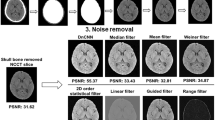Abstract
Training deep learning models to identify diseases like intracranial haemorrhage (ICH) requires a huge labelled dataset. Lack of a huge labelled data set is a common issue for diseases like ICH. To overcome this issue, in this work, we propose a completely unsupervised deep learning framework for the identification of ICH in computed tomography (CT) images. Our proposed method employs unsupervised (principal component analysis) PCA-Net to extract features from CT images. Further, we trained a K-means classifier using the extracted features from PCA-Net to identify ICH in a completely unsupervised fashion, without making use of any class labels. We also trained a supervised linear support vector machine (SVM) classifier using the extracted features from PCA-Net for a comparative study against the K-means algorithm. We trained both PCA-Net with K-means (fully unsupervised) and PCA-Net with linear SVM models using 1750 CT slices. We tested the models with 751 CT slices (88 slices with ICH and 663 slices without ICH). During testing, our proposed method achieved an accuracy of 0.67, a weighted average precision of 0.80, a weighted average recall of 0.67, and a weighted average F1-score of 0.72. Considering the small size of our training set, our proposed unsupervised framework (PCA-Net + K-means) did a fair job identifying ICH in CT images. Thus, our proposed model can act as a completely unsupervised framework for ICH identification in CT images. Thereby, solving the problem of lack of a huge labelled data set for ICH identification using deep learning models.
Access this chapter
Tax calculation will be finalised at checkout
Purchases are for personal use only
Similar content being viewed by others
References
Van Asch CJ, Luitse MJ, Rinkel GJ, van der Tweel I, Algra A, Klijn CJ (2010) Incidence, case fatality, and functional outcome of intracerebral haemorrhage over time, according to age, sex, and ethnic origin: a systematic review and meta-analysis. Lancet Neurol 9(2):167–176
Simon A, Vinayakumar R, Sowmya V, Soman KP, Gopalakrishnan EAA (2019) A deep learning approach for patch-based disease diagnosis from microscopic images. In: Classification techniques for medical image analysis and computer aided diagnosis. Academic Press, pp 109–127
Anupama MA, Sowmya V, Soman KP (2019) Breast cancer classification using capsule network with preprocessed histology images. In: 2019 International conference on communication and signal processing (ICCSP). IEEE, pp 0143–0147
Harini N, Ramji B, Sriram S, Sowmya V, Soman KP (2020) Musculoskeletal radiographs classification using deep learning. In: Deep learning for data analytics. Academic Press, pp. 79–98
Lam C, Yi D, Guo M, Lindsey T (2018) Automated detection of diabetic retinopathy using deep learning. In: AMIA summits on translational science proceedings, vol 2018, p 147
Simon A, Vinayakumar R, Sowmya V, Dr. Soman KP (2019) Shallow CNN with LSTM layer for tuberculosis detection in microscopic image. Int J Recent Technol Eng 7:56–60
Chan TH, Jia K, Gao S, Lu J, Zeng Z, Ma Y (2015) PCANet: a simple deep learning baseline for image classification? IEEE Trans Image Process 24(12):5017–5032
Chang PD, Kuoy E, Grinband J, Weinberg BD, Thompson M, Homo R, Chen J, Abcede H, Shafie M, Sugrue L, Filippi CG (2018) Hybrid 3D/2D convolutional neural network for hemorrhage evaluation on head CT. Am J Neuroradiol 39(9):1609–1616
Arbabshirani MR, Fornwalt BK, Mongelluzzo GJ, Suever JD, Geise BD, Patel AA, Moore GJ (2018) Advanced machine learning in action: identification of intracranial hemorrhage on computed tomography scans of the head with clinical workflow integration. NPJ Digit Med 1(1):1–7
Jnawali K, Arbabshirani MR, Rao N, Patel AA (2018) Deep 3D convolution neural network for CT brain hemorrhage classification. In: Medical imaging 2018: computer-aided diagnosis, vol 10575. International Society for Optics and Photonics, p 105751C
Grewal M, Srivastava MM, Kumar P, Varadarajan S (2018) RADnet: radiologist level accuracy using deep learning for hemorrhage detection in CT scans. In: 2018 IEEE 15th international symposium on biomedical imaging (ISBI 2018). IEEE, pp 281–284
Ye H, Gao F, Yin Y, Guo D, Zhao P, Lu Y, Wang X, Bai J, Cao K, Song Q, Zhang H (2019) Precise diagnosis of intracranial hemorrhage and subtypes using a three-dimensional joint convolutional and recurrent neural network. Euro Radiol 29(11):6191–6201
Lee H, Yune S, Mansouri M, Kim M, Tajmir SH, Guerrier CE, Ebert SA, Pomerantz SR, Romero JM, Kamalian S, Gonzalez RG (2019) An explainable deep-learning algorithm for the detection of acute intracranial haemorrhage from small datasets. Nat Biomed Eng 3(3):173
Dhanachandra N, Manglem K, Chanu YJ (2015) Image segmentation using K-means clustering algorithm and subtractive clustering algorithm. Procedia Comput Sci 54:764–771
Fan RE, Chang KW, Hsieh CJ, Wang XR, Lin CJ (2008) LIBLINEAR: a library for large linear classification. J Mach Learn Res 9(August):1871–1874
Hssayeni M (2019) Computed tomography images for intracranial hemorrhage detection and segmentation (version 1.0.0), PhysioNet. Available at https://doi.org/10.13026/w8q8-ky94
Pedregosa F, Varoquaux G, Gramfort A, Michel V, Thirion B, Grisel O, Blondel M, Prettenhofer P, Weiss R, Dubourg V, Vanderplas J (2011) Scikit-learn: Machine learning in Python. J Mach Learn Res 12:2825–2830
Author information
Authors and Affiliations
Corresponding author
Editor information
Editors and Affiliations
Rights and permissions
Copyright information
© 2022 The Author(s), under exclusive license to Springer Nature Singapore Pte Ltd.
About this chapter
Cite this chapter
Ganeshkumar, M., Sowmya, V., Gopalakrishnan, E.A., Soman, K.P. (2022). Unsupervised Deep Learning Approach for the Identification of Intracranial Haemorrhage in CT Images Using PCA-Net and K-Means Algorithm. In: Saraswat, M., Sharma, H., Arya, K.V. (eds) Intelligent Vision in Healthcare. Studies in Autonomic, Data-driven and Industrial Computing. Springer, Singapore. https://doi.org/10.1007/978-981-16-7771-7_3
Download citation
DOI: https://doi.org/10.1007/978-981-16-7771-7_3
Published:
Publisher Name: Springer, Singapore
Print ISBN: 978-981-16-7770-0
Online ISBN: 978-981-16-7771-7
eBook Packages: Intelligent Technologies and RoboticsIntelligent Technologies and Robotics (R0)




